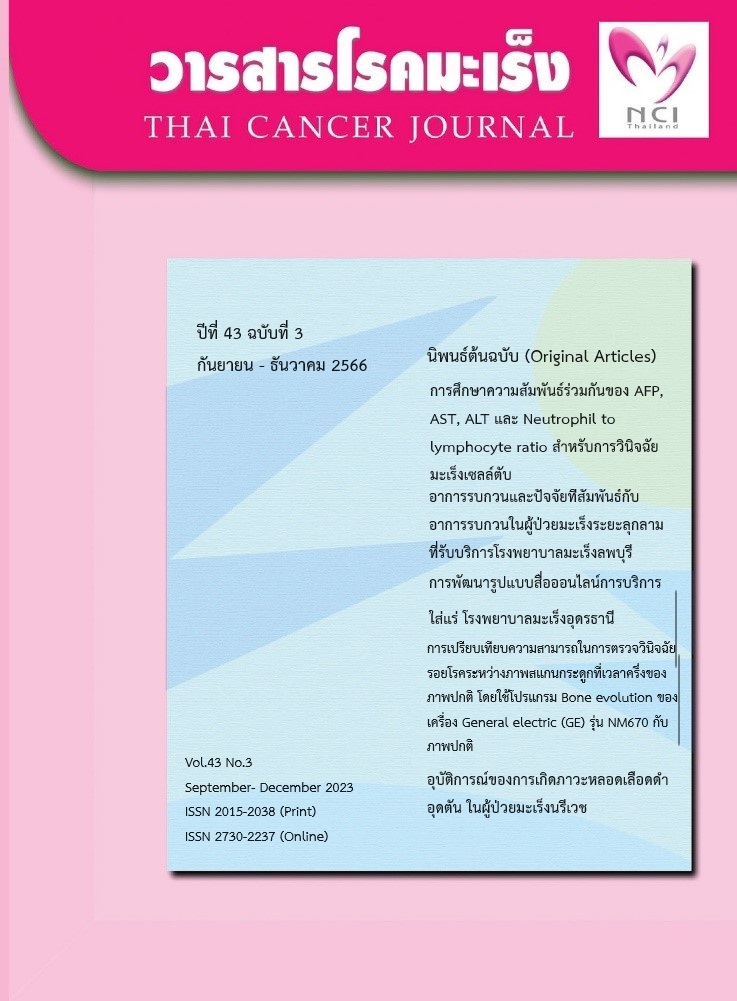Symptom distress and factors related to symptom distress in advanced cancer patient at Lopburi Cancer Hospital
Keywords:
symptoms, factors related to symptoms, advanced cancer patientAbstract
A cross-sectional study with retrospective data collection. Objective: To study the characteristics of disturbing symptoms and factors associated with disturbing symptoms in patients with advanced cancer. The sample consisted of 360 patients with advanced cancer of seven types, including lung, colon, breast, cervical, head and neck, liver and biliary tract, who received care at Lopburi Cancer Hospital between February 1, 2022-February 28, 2023. Patient medical records were collected and analyzed using descriptive statistics and chi-square tests. The results showed that the sample was diagnosed with advanced cancer, classified by organ as follows: lung: 32.4%, breast: 22.2%, head and neck cancer: 15.3%, colon: 12.2%, liver: 7.0%, cervix: 6.5% and biliary tract: 4.4%. The five most common disturbing symptoms in patients with advanced cancer were pain 84%, fatigue 73%, discomfort 68%, shortness of breath 55% and anxiety 48%. The three most associated factors with disturbing symptoms were location of metastasis, method of disturbing symptom management, and palliative performance scale. Specifically, 1. Breast cancer that metastasized to bone and breast cancer that did not metastasize to brain were associated with pain P=0.001, P=0.009, respectively; breast cancer that metastasized to bone was associated with fatigue P=0.042 and breast cancer that did not metastasize to brain was associated with discomfort P=0.046. 2. The method of disturbing symptom management was associated with fatigue and discomfort P=0.001. 3. Palliative performance scale was associated with pain, fatigue, and discomfort P=0.002, P=0.016, P=0.043, respectively. The three most important disturbing symptoms in patients with advanced cancer were pain, fatigue, and discomfort. The factors associated with disturbing symptoms were location of metastasis, method of disturbing symptom management, and palliative performance scale. Further studies are needed to explore the management of pain, fatigue, discomfort, shortness of breath, and anxiety in the future.
References
Ferlay J, Colombet M, Soerjomataram I, Parkin DM, Piñeros M, Znaor A, et al. Cancer statisticsfor the year 2020: An overview. International Journal of Cancer. 2021;149(4):778–89
กองยุทธศาสตร์และแผนงาน สำนักงานปลัดกระทรวงสาธารณสุข. สถิติสาธารณสุข พ.ศ. 2564
พวงทอง ไกรพิบูลย์. อยู่กับมะเร็งอย่างเป็นสุข. กรุงเทพมหานคร: ซีเอ็ดยูเคชั่น; 2551.
วราภรณ์ ภูธิวุฒิ, อิสระ เจียวิริยบุญญา. อัตราการรอดชีพผู้ป่วยโรคมะเร็งที่พบมาก 5 อันดับแรก ที่เข้ารับการรักษาปี 2553
ในโรงพยาบาลมะเร็งอุดรธานี. Journal of The Department of Medical Services.2019;44(1):81–6.
Howlader N, Noone AM, Krapcho M, Miller D, Brest A, Yu M, et al. SEER Cancer Statistics
Review,1975-2018, National Cancer Institute. Bethesda, MD. 2021.
สุชาวดี รุ่งแจ้ง, รัชนี นามจันทรา. การจัดการอาการในผู้ป่วยมะเร็งปอดระยะลุกลาม. Thai Journal of Cardio-Thoracic Nursing. 2016;27(2):43–57
นภา ทวียรรยงกุล, สุชิรา ชัยวิบูลย์ธรรม, บัวหลวง สำแดงฤทธิ์. ประสบการณ์อาการ และการจัดการใน
ผู้ป่วยมะเร็งระยะลุกลามที่ได้รับการดูแลแบบประคับประคอง. 2558 [cited 2023 Jul 13]; Available from: https://repository.li.mahidol.ac.th/handle/123456789/47970
Kaye AD, Baluch A, Scott JT. Pain Management in the Elderly Population: A Review. Ochsner Journal. 2010;10(3):179–87.
กิติกร นิลมานัต, วงจันทร์ เพชรพิเชฐเชียร, วันธณี วรุฬห์พานิช, สุรีย์พร กฤษเจริญ. การสำรวจ ประสบการณ์อาการที่พบบ่อยและการจัดการอาการของผู้ป่วยมะเร็งในประเทศไทย. มหาวิทยาลัยสงขลานครินทร์; 2549.
วิภาดา พึ่งสุข, พิษณุรักษ์ กันทวี, ภัทรพล มากมี. ปัจจัยที่มีความสัมพันธ์ต่อคุณภาพชีวิตของผู้ป่วยโรคมะเร็งที่ได้รับการดูแลแบบประคับประคองในระยะท้าย จังหวัดเชียงราย. Nursing Journal of The Ministry of Public Health. 2019;29(2):116–28.
Park SA, Chung SH, Lee Y. Factors influencing the quality of life of patients with advanced cancer. Applied Nursing Research. 2017; 33:108–12.
Leleszi JP, Lewandowski JG. Pain Management in End-of-Life Care. Journal of Osteopathic
Medicine. 2005 Mar 1;105(s3):6–11.
Chinda M, Jaturapatporn D, Kirshen AJ, Udomsubpayakul U. Reliability and Validity of a Thai Version of the Edmonton Symptom Assessment Scale (ESAS-Thai). Journal of Pain and Symptom Management. 2011;42(6):954–60.
แสงระวี แทนทอง, อำภาพร นามวงศ์พรหม, น้ำอ้อย ภักดีวงศ์. ประสบการณ์อาการและคุณภาพชีวิตของ ผู้ป่วยมะเร็งระยะลุกลามที่ได้รับรังสีรักษา. APHEIT Journal of Nursing and Health. 2016;5(1):39– 47.
Enblom A, Bergius Axelsson B, Steineck G, Hammar M, Börjeson S. One third of patients with radiotherapy-induced nausea consider their antiemetic treatment insufficient. Support Care Cancer. 2009;17(1):23–32.
Lueboonthavatchai P. Prevalence and psychosocial factors of anxiety and depression in breast cancer patients. Journal-Medical Association of Thailand. 2007;90(10):21–64.
Gorman JM. Gender differences in depression and response to psychotropic medication. Gender Medicine. 2006;3(2):93–109.
บุษยามาส ชีวสกุลยง. คู่มือการดูแลผู้ป่วยระยะท้ายและครอบครัว. กรุงเทพมหานคร: บียอนด์ เอ็นเทอร์ไพรซ์ จำกัด
Jindakul P, Namvongprom A, Pakdevong Noy. ประสิทธิผลของโปรแกรมการสนับสนุนและให้ ความรู้ต่อความสามารถในการดูแลตัวเอง การรับรู้ความรุนแรงของอาการข้างเคียงจากเคมีบำบัด และ ความวิตกกังวลในผู้ป่วยมะเร็งเต้านมระยะแรกที่เข้ารับการรักษาเสริมด้วยเคมีบำบัด. Thai Cancer Journal. 2018;38(3):105–16.
ฉัตรกมล เจริญวิภาดา. กรณีศึกษา: การพยาบาลผู้ป่วยมะเร็งระยะสุดท้าย ต่อเนื่องจากสถานพยาบาลไปยังบ้านและชุมชนในบริบทของศูนย์การดูแลแบบประคับประคอง หน่วยงานให้คำปรึกษา กลุ่มการพยาบาล โรงพยาบาลคลองท่อม. Krabi Medical Journal.2017; 1(1):11–21.
Downloads
Published
Issue
Section
License
Copyright (c) 2024 Thailand's National Cancer Institute Foundation

This work is licensed under a Creative Commons Attribution-NonCommercial-NoDerivatives 4.0 International License.
บทความทีตีพิมพ์ในวารสารโรคมะเร็งนี้ถือว่าเป็นลิขสิทธิ์ของมูลนิธิสถาบันมะเร็งแห่งชาติ และผลงานวิชาการหรือวิจัยของคณะผู้เขียน ไม่ใช่ความคิดเห็นของบรรณาธิการหรือผู้จัดทํา







